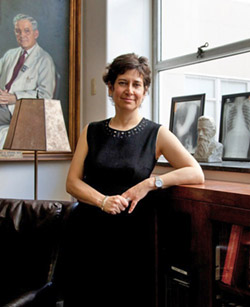UC DOSE Project and Recent Research Call for Standard Protocols for CT Scan Doses
 The UCSF CT International Dose Registry, created to broaden patients' protection from excessive radiation, is expanding this year thanks to new funding from the Patient-Centered Outcomes Research Institute (PCORI) and Centers for Medicare & Medicaid Services (CMS).
The UCSF CT International Dose Registry, created to broaden patients' protection from excessive radiation, is expanding this year thanks to new funding from the Patient-Centered Outcomes Research Institute (PCORI) and Centers for Medicare & Medicaid Services (CMS).
Led by UCSF Radiology's Rebecca Smith-Bindman, MD, the registry is an initiative to improve patient safety by standardizing the protocols and doses used in computed tomography (CT). Initially funded by the UC Office of the President, it has grown over the past five years to now contain a record of more than 5 million radiation doses used in CT across a large number of institutions in the U.S., Canada, and the U.K.
CT uses ionizing radiation, which can increase cancer risk, in diagnostic imaging. But radiation doses vary substantially across patients and institutions, and few standards exist to assure that doses are as low as reasonably achievable (ALARA). While higher doses can lead to better resolution images, there is no evidence that higher doses lead to more accurate diagnosis. Dr. Smith-Bindman and her team believe CT doses can be reduced by 50 percent or more without reducing diagnostic accuracy.
According to Dr. Smith-Bindman, variation in dose reflects practice preferences, not evidence, and the strongest predictor of a patient's dose is where they go for imaging, not patient, machine, or model factors, or why they are imaged. Most organizations (hospitals, outpatient facilities) do not even know what doses are used among their practitioners.
Further, a recently-completed international study led by UCSF found that dose variation is largely due to differences in the technical settings of the scanning machines at each institution.
Dr. Smith-Bindman, lead author, and her co-authors from 17 other institutions internationally recommend that consistent international standards be established for optimizing doses without sacrificing accuracy.
Their study, which appears in the British medical publication The BMJ, used data collected from the UCSF CT International Dose Registry between November 2015 and August 2017. The researchers analyzed records of more than 2 million diagnostic CT scans conducted on 1.7 million adults in 151 institutions across seven countries (Switzerland, Netherlands, Germany, United Kingdom, United States, Israel and Japan).
The researchers found that the largest driver of dose variation was how providers or clinical staff at each institution set the machine's technical parameters, including X-ray tube settings, number of scans per scanning session, and the total area of the body being scanned.
Dr. Smith-Bindman said that the current common practice and expectation is that CT dose standards and benchmarks should be created individually by each hospital, region, or country.
"This practice is driven by the belief that differences in the types and models of CT machines, and characteristics of local patient populations, require this local creation of standards," she said. "But given our results, this does not make sense. A single set of achievable quality standards for radiation dose should be set and applied to all hospitals and imaging facilities."
Dr. Smith-Bindman, a professor-in-residence of Radiology, Epidemiology and Biostatistics, and of Obstetrics, Gynecology and Reproductive Medicine, also leads the UC DOSE Collaboration, a collaborative working group of radiologists, physicists, CT technologists, data scientists, programmers, epidemiologists, and biostatisticians across the five UC Medical Centers. Its primary goal has been to pool data to improve practice, with help from Radimetrics, a medical imaging radiation dose monitoring software company. The UC DOSE project found considerable variation in CT radiation doses among UC campuses, some of which could be explained by patient and scanner factors, but most due to individual campus preferences in CT protocols.
Dr. Smith-Bindman's research has resulted in several conclusions as to how to best standardize the doses used for CT:
- Institutions need to know how they are performing in comparison with other institutions to know what is possible.
- The more granular the information institutions review, the easier it is to implement changes.
- Sharing best practices allows facilities to improve.
- Integrating quality improvement activities into routine practice makes improvement accessible.
- Machine characteristics are surprisingly unimportant compared with how machines are used – meaning everyone should target the same low doses.
The project's new funding from CMS provides $5 million to support the creation of a quality measure for CT that can be used in the CMS pay-for-performance program.
"We have sites in Asia and are currently expanding with a target of enrolling over one thousand new sites in the United States and abroad," said Dr. Smith-Bindman. Interested organizations can contact Jessie De Guzman, who is the project coordinator leading expansion. CORI, which helped fund the registry's initial expansion, is also providing $1 million in new money so that more institutions can be invited to join. Institutions will be given feedback on their doses and concrete suggestions for improving. It also will create opportunities for institutions to participate in virtual and in-person meetings to share best practices.
Dr. Smith-Bindman is a member of the UCSF Philip R. Lee Institute for Health Policy Studies and the UCSF Helen Diller Family Comprehensive Cancer Center.
NOTE: The international study led by UCSF was funded by the National Institutes of Health (R01-CA181191); the Patient-Centered Outcomes Research Institute (CD-1304-7043); the Centers for Disease Control and Prevention; and the UC Office of the President, Center for Health Quality and Innovation. Co-authors include researchers at UC Berkeley; UC Davis; UC San Diego; Assuta Medical Center; Tel Aviv-Yafo, Israel; Cantonal Hospital Aarau, Switzerland; Churchill Hospital, Oxford, UK; Columbia University Medical Center; Einstein Healthcare Network, NY; Essen University, Essen, Germany; Helios Kliniken Duisburg, Duisburg, Germany; Henry Ford Health System, Detroit, MI; Icahn School of Medicine at Mount Sinai, NY; Kaiser Permanente Washington, Seattle, WA; Aarau, Switzerland; St. Luke's International Hospital, Tokyo, Japan; and University Hospital Essen, Essen, Germany.
